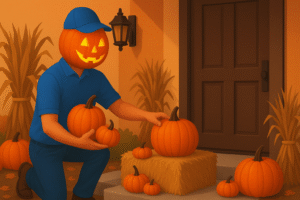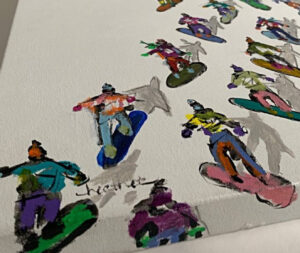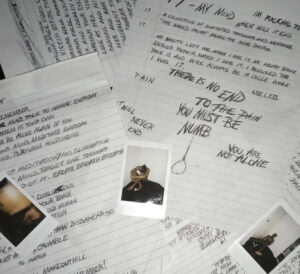
In 2024, KAWS unveiled Cereal Monsters, a set of four painted cast vinyl figures that distill his signature vocabulary into a new collectible form. Equal parts ironic homage and aesthetic critique, the Cereal Monsters embody the artist’s ongoing engagement with the semiotics of commercial imagery. They channel the lurid colors and exaggerated emotions of vintage cereal mascots—think Franken Berry or Count Chocula—through the visual lens of KAWS’s melancholic, dead-eyed figures. These works, like much of KAWS’s oeuvre, sit at the intersection of nostalgia, consumerism, and a postmodern reinterpretation of mass-produced joy.
This article takes an expansive look at Cereal Monsters, situating the series within the artist’s broader trajectory, placing it in dialogue with art history, and examining its resonance in today’s visual culture. Through a combination of material analysis, aesthetic criticism, historical context, and market insight, we explore how KAWS continues to complicate the lines between art and object, play and pathology, consumption and contemplation.
From Street to Studio: KAWS and the Evolution of Style
KAWS (born Brian Donnelly, 1974) emerged from the street art scene of 1990s New York, particularly through his subversive interventions into public advertising. His early practice involved “subvertising”: hijacking bus stop ads and billboards to inject his own characters—most notably the “Companion,” a skull-faced, cartoon-like figure with X-ed out eyes—into mass-market imagery. From these origins, KAWS developed a visual language that would come to dominate both fine art spaces and global streetwear culture.
His works span an impressive range of mediums: canvas paintings that echo the structure and surface of animation cells; massive inflatable installations that tower over cityscapes; collectible vinyl figures that merge street cred with pop surrealism. At the core of it all is a commitment to image-making—an exploration of how icons work on us, and how we in turn work on them.
With Cereal Monsters, KAWS returns to the smaller scale of collectible art toys, a format he helped popularize in the early 2000s alongside contemporaries like Takashi Murakami and Medicom. These figures recall his early collaborations with Japanese toy brands, but with a matured sculptural finesse and a deeper resonance rooted in childhood nostalgia.
A Pop Lexicon: Cereal Mascots and American Semiotics
The Cereal Monsters collection takes as its starting point the kitschy, luridly lovable mascots of sugary breakfast cereals—a genre that flourished in postwar America as both marketing tool and cultural artifact. Characters like Boo Berry, Yummy Mummy, and Count Chocula weren’t just product pitchmen; they were entry points into branded fantasy worlds for generations of children.
KAWS appropriates this visual language with characteristic irony. His monsters are less manic and more mournful. Their heads droop, their features are exaggerated yet strangely fragile. The familiar cartoon tropes—round eyes, rubber limbs, overbite grins—are refracted through his signature stylistic filters: soft contoured outlines, matte vinyl texture, and most iconically, the cross-eyed “X” pupils that signal a kind of emotional vacancy or quiet resignation.
These works do not simply parody the cereal mascot. They mythologize it. KAWS transforms marketing ephemera into sculptural avatars of late capitalist emotion—icons of unfulfilled desire dressed in breakfast colors.
Vinyl as Vessel: Material Considerations
The use of painted cast vinyl is a deliberate and significant choice. Vinyl, historically dismissed as a “low” material in the hierarchy of sculpture, has in recent decades gained new status through the world of designer toys, particularly in Japan and urban pop circles. Vinyl is affordable, replicable, and luminous under certain lights—a medium at once tactile and alien.
By using cast vinyl for the Cereal Monsters, KAWS resituates the object within both commercial and gallery contexts. These are toys, yes—but also limited editions, investment pieces, objects of aesthetic speculation. The surface treatment—bold fields of acrylic color, almost like screen-printed planes—echoes the Pop Art tradition of Warhol, Lichtenstein, and Oldenburg. Yet the tactility of vinyl, with its industrial finish and palpable nostalgia, moves the conversation into the 21st century.
Much like his larger fiberglass works or bronze Companions, these smaller vinyl sculptures speak to the economy of repetition and the fetishization of material. Their reproducibility doesn’t detract from their aura; it is their aura.
The Laughing Monster, The Crying Clown: Humor and Melancholy in KAWS
A defining feature of KAWS’s practice is the emotional ambiguity his characters convey. They are funny but sad, familiar but estranged. In the Cereal Monsters, this tension is even more pronounced. These characters are conceptually light, but visually heavy. Their exaggerated postures and expressions recall not just cartoon exuberance, but the psychological weight of identity in a media-saturated world.
The figures might appear childlike at first glance, but their affect is often more Beckettian than Bugs Bunny. They sag. They stare blankly. They are existential mascots.
This duality—playful form with emotional weight—is what elevates KAWS’s work beyond simple pop art. It places him closer to the melancholic figuration of Yoshitomo Nara, or even the absurdist strategies of Paul McCarthy. His creatures are emotional surrogates in a post-sincerity age. We laugh at them. We pity them. We collect them. And in so doing, we reveal the mechanics of our own projection.
Exhibitions, Institutional Recognition, and Market Reach
KAWS’s ascent from street-level provocateur to institutional darling has been nothing short of remarkable. His exhibitions now span some of the world’s leading museums and art foundations, including the Brooklyn Museum, Yuz Museum (Shanghai), Modern Art Museum of Fort Worth, and Yorkshire Sculpture Park. In 2021, the Brooklyn Museum’s exhibition KAWS: WHAT PARTY became one of the institution’s most-visited contemporary shows, drawing crowds from sneakerheads to fine art collectors.
Simultaneously, KAWS dominates the commercial art market. His vinyl figures routinely resell for 5 to 10 times their original price, while large-scale paintings and sculptures fetch millions at auction. What distinguishes KAWS is that he operates fluently across both spheres—museum halls and hype drops, blue-chip auctions and pop-up stores. He is both a contemporary artist and a global brand.
The Cereal Monsters are a microcosm of that fluidity. They are playful, collectible, sculptural, and referential. They can be displayed in a child’s bedroom, a minimalist gallery, or an executive’s private office. Their polyvalence is key to their cultural resonance.
KAWS in Context: From Warhol to the Metaverse
To fully appreciate Cereal Monsters, one must place KAWS in a broader artistic lineage. He inherits the legacy of Pop Art, particularly Warhol’s fascination with consumer imagery, but he reframes it through the lens of the post-analog world. Where Warhol silkscreened soup cans and celebrities, KAWS reconstructs cartoons and mascots. Where Roy Lichtenstein mimicked comic strips, KAWS remixes commercial culture through sculpture and collectibles.
Yet KAWS also gestures forward—toward digital and immersive cultures. His characters have appeared in Fortnite, on Travis Scott album covers, and in collaborative fashion capsules with Uniqlo, Dior, and Supreme. In this way, he represents the migration of visual culture from print to pixel, from static canvas to participatory platforms.
The Cereal Monsters might one day exist as NFTs, or appear in an AR art experience. But their vinyl form—tactile, physical, weighty—also reminds us of the enduring power of the object in an age of digital ephemera.
Impression
With Cereal Monsters, KAWS delivers more than collectible sculpture. He offers a meditation on the aesthetic life of objects, the haunted joy of nostalgia, and the strange emotionality of branded innocence. These works crystallize the contradictions that animate our media landscape: they are at once cynical and sentimental, ironic and sincere, playful and profound.
In appropriating the visual vocabulary of cereal mascots, KAWS does not merely parody a marketing strategy. He mythologizes it. He reveals its psychological depth. He shows us that beneath the sugary surface of childhood whimsy lies a powerful commentary on memory, consumption, and affect.
KAWS has long challenged the boundaries between art and toy, gallery and mall, sculpture and commodity. With Cereal Monsters, he doesn’t just blur those lines—he paints them in neon vinyl and invites us to feel the weight of our laughter.
No comments yet.








